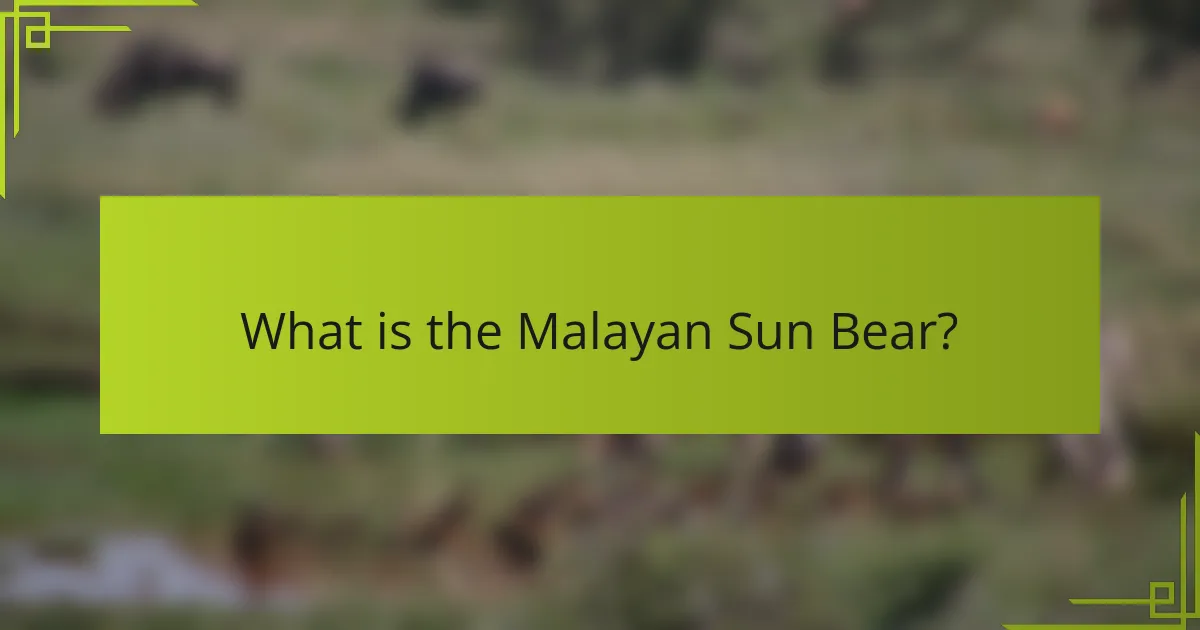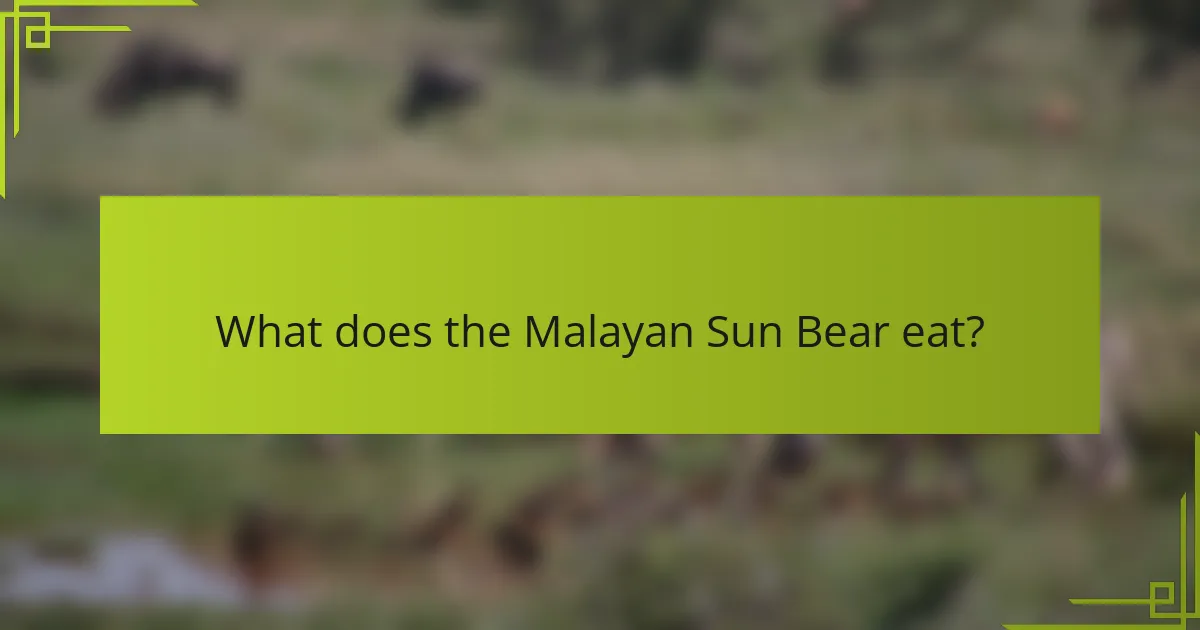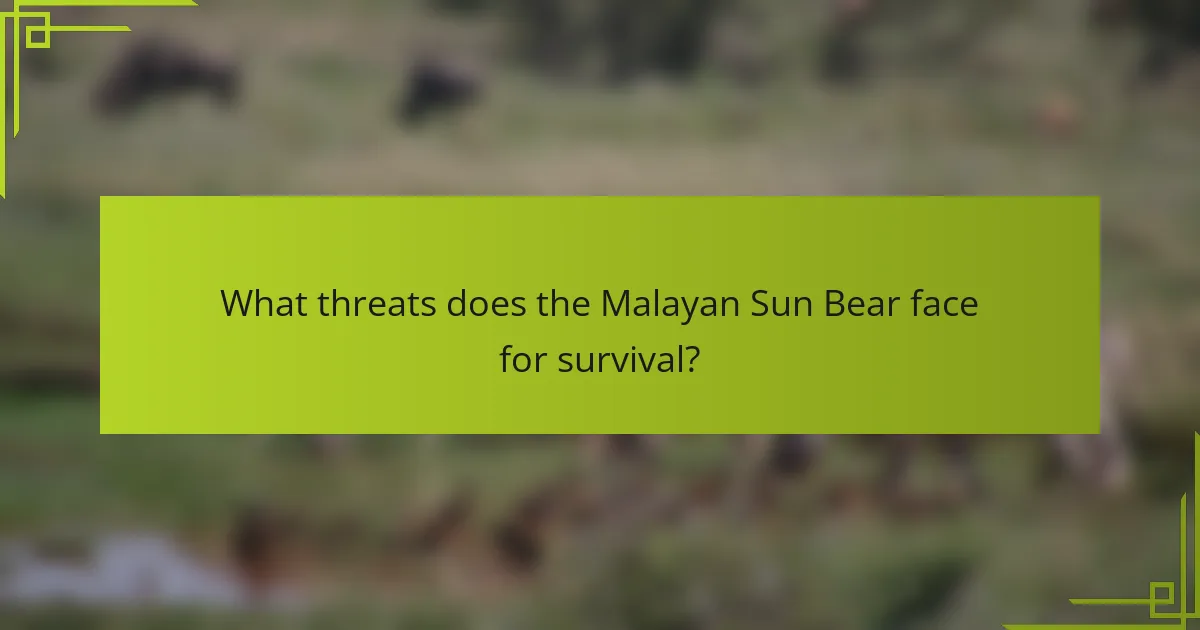The Malayan Sun Bear is the smallest bear species globally, native to the tropical forests of Southeast Asia. Characterized by its short, sleek black coat and a distinctive crescent-shaped mark on its chest, this bear primarily feeds on fruits, honey, and insects, utilizing its long tongue to access hard-to-reach food sources. Despite its unique adaptations, the Malayan Sun Bear faces significant threats, including habitat loss due to deforestation, poaching for body parts, and the impacts of climate change. Conservation efforts are underway to protect this vulnerable species and its natural habitat, addressing the various challenges to its survival.

What is the Malayan Sun Bear?
The Malayan Sun Bear is the smallest bear species in the world. It is native to the tropical forests of Southeast Asia. This bear has a distinctive short, sleek coat that is typically black with a yellow or white crescent-shaped mark on its chest. Malayan Sun Bears have a long tongue, which they use to extract honey and insects from trees. They are primarily nocturnal and spend much of their time climbing trees. Their diet consists mainly of fruits, honey, and small invertebrates. Malayan Sun Bears are classified as vulnerable due to habitat loss and poaching. Conservation efforts are ongoing to protect their natural habitat and reduce threats to their survival.
How does the Malayan Sun Bear differ from other bear species?
The Malayan Sun Bear differs from other bear species primarily in its size and physical characteristics. It is the smallest bear species, typically weighing between 60 to 150 pounds. Its short, sleek fur is usually black with a distinctive orange to cream-colored chest patch. This bear has a longer tongue, which it uses for extracting insects and honey from trees. Unlike larger bears, the Malayan Sun Bear is more arboreal, spending considerable time in trees. Its diet is also unique, consisting mainly of fruits, insects, and honey, rather than the more omnivorous diets of other bears. Additionally, they have a distinctive lack of fat reserves, which is uncommon among bear species. These adaptations allow the Malayan Sun Bear to thrive in its tropical forest habitat.
What are the distinctive physical characteristics of the Malayan Sun Bear?
The Malayan Sun Bear has several distinctive physical characteristics. It is the smallest bear species, typically weighing between 60 to 150 pounds. Its fur is short and sleek, predominantly black with a unique orange to cream-colored chest patch. This chest patch often resembles a rising sun, giving the bear its name. The Malayan Sun Bear has a long, slender body and short legs, adapted for climbing. Its snout is elongated, which aids in foraging for insects and fruits. Additionally, it has large, curved claws that assist in climbing trees and digging. These physical traits enable the Malayan Sun Bear to thrive in its tropical forest habitat.
What is the typical size and weight of the Malayan Sun Bear?
The typical size of the Malayan Sun Bear ranges from 4.5 to 5.5 feet in length. [censured] Malayan Sun Bears usually weigh between 60 to 150 pounds. Males tend to be larger than females. Their height at the shoulder is approximately 2 to 3 feet. These dimensions make them the smallest bear species. Their compact size allows them to navigate dense forest habitats effectively.
What is the geographical distribution of the Malayan Sun Bear?
The Malayan Sun Bear is primarily found in Southeast Asia. Its geographical distribution includes countries such as Malaysia, Thailand, Indonesia, and Vietnam. The species inhabits tropical rainforests and lowland forests. They are also present in hilly and mountainous regions. The Malayan Sun Bear prefers dense forest cover for shelter and foraging. Their range is increasingly fragmented due to deforestation and habitat loss. Conservation efforts are ongoing to protect their remaining habitats. Studies highlight the bear’s reliance on specific forest types for survival.
In which countries can the Malayan Sun Bear be found?
The Malayan Sun Bear can be found in several countries in Southeast Asia. Its range includes Malaysia, Indonesia, Thailand, and Myanmar. These bears inhabit tropical rainforests. They prefer lowland forests and mountainous regions. The Malayan Sun Bear is primarily found in the Malay Peninsula. They also reside on the islands of Borneo and Sumatra. Their habitat is increasingly threatened by deforestation. Conservation efforts are crucial for their survival in these regions.
What types of habitats do Malayan Sun Bears prefer?
Malayan Sun Bears prefer tropical rainforests as their primary habitat. These bears thrive in dense, humid environments rich in vegetation. They are often found in lowland forests and mountainous areas. Malayan Sun Bears require access to fruiting trees, which are abundant in these habitats. They also inhabit secondary forests and disturbed areas. Their preference for diverse habitats supports their foraging behavior. Studies indicate that they are adaptable to various forest types. This adaptability helps them survive in changing environments.

What does the Malayan Sun Bear eat?
The Malayan Sun Bear primarily eats fruits, insects, and honey. They are omnivorous and have a diverse diet. Sun bears consume a variety of fruits, including figs and berries. They also eat termites and ants, which provide protein. Honey is a significant part of their diet, as they are skilled at accessing bee nests. Their long tongues help them extract honey from difficult locations. Sun bears are known to forage for food in trees and on the ground. This varied diet supports their nutritional needs in their natural habitat.
What is the primary diet of the Malayan Sun Bear?
The primary diet of the Malayan Sun Bear consists mainly of fruits, insects, and honey. They are known to consume a variety of fruits, which are abundant in their forest habitat. Insects, particularly ants and termites, also form a significant part of their diet. Honey is a favored food source, and they have strong claws for accessing beehives. This omnivorous diet allows them to adapt to different food availability throughout the year. Studies indicate that their foraging behavior is crucial for seed dispersal in their ecosystem.
What specific foods do Malayan Sun Bears consume?
Malayan Sun Bears primarily consume fruits, insects, and honey. They are known to eat various fruits such as durian and rambutan. Insects, particularly ants and termites, constitute a significant part of their diet. Honey is a favored treat, and they often seek out beehives. Additionally, they may consume small vertebrates and plant matter. Their foraging behavior is adapted to their tropical forest habitat, allowing them to access diverse food sources. Research indicates that their diet is crucial for seed dispersal in their ecosystem.
How does the diet of the Malayan Sun Bear vary seasonally?
The diet of the Malayan Sun Bear varies seasonally based on food availability. During the fruiting season, they primarily consume fruits like durian and rambutan. In other seasons, their diet shifts to include insects, honey, and small vertebrates. This adaptation helps them meet nutritional needs throughout the year. Seasonal changes in rainfall and temperature influence the availability of these food sources. Research indicates that sun bears are opportunistic feeders, adjusting their diet according to what is most abundant. Their foraging behavior reflects this flexibility, allowing them to thrive in diverse habitats.
How do Malayan Sun Bears obtain their food?
Malayan Sun Bears obtain their food primarily through foraging. They are omnivorous and consume a variety of foods. Their diet includes fruits, insects, and small vertebrates. Sun bears use their long tongues to extract honey from beehives. They also dig for termites and ants using their strong claws. Their foraging behavior is essential for their survival. Studies show that they can travel several kilometers in search of food. This adaptability helps them thrive in their forest habitat.
What foraging techniques do Malayan Sun Bears use?
Malayan Sun Bears use a variety of foraging techniques to find food. They primarily rely on their excellent sense of smell to locate food sources. These bears often dig into the ground to unearth insects and larvae. They also climb trees to access honey and fruit. Their long tongues help them extract honey from beehives. Additionally, they use their strong claws to break open tree bark for insects. Observations show that they are opportunistic feeders, consuming whatever is available. Their foraging behavior is crucial for their survival in the wild.
How does their diet impact the ecosystem they inhabit?
The diet of the Malayan Sun Bear significantly impacts their ecosystem. As omnivores, they consume a variety of foods including fruits, insects, and small vertebrates. This feeding behavior aids in seed dispersal, promoting forest regeneration. By consuming insects, they help control pest populations, maintaining ecological balance. Their foraging habits also create opportunities for other species to access food sources. The decline of sun bears can lead to increased insect populations and reduced plant diversity. Therefore, their diet plays a crucial role in sustaining the health of their habitat.

What threats does the Malayan Sun Bear face for survival?
The Malayan Sun Bear faces several threats to its survival. Habitat loss is a significant issue, primarily due to deforestation for agriculture and logging. According to the World Wildlife Fund, over 50% of the Malayan Sun Bear’s habitat has been lost in the past few decades. Poaching poses another critical threat, as bears are hunted for their body parts, which are used in traditional medicine. Climate change also impacts their habitat, altering food availability and increasing the frequency of extreme weather events. Additionally, human-wildlife conflict occurs when bears venture into agricultural areas, leading to retaliatory killings. These factors collectively contribute to the declining population of the Malayan Sun Bear, classified as vulnerable by the International Union for Conservation of Nature.
What are the main threats to the Malayan Sun Bear population?
The main threats to the Malayan Sun Bear population are habitat loss, poaching, and illegal wildlife trade. Habitat loss occurs due to deforestation for agriculture and urban development. This reduces the bears’ natural living space and food sources. Poaching poses a direct threat as bears are hunted for their body parts and for the pet trade. Illegal wildlife trade further endangers the species by removing individuals from their natural habitats. According to the IUCN Red List, the Malayan Sun Bear is classified as vulnerable, highlighting the urgency of addressing these threats.
How does habitat destruction affect the Malayan Sun Bear?
Habitat destruction significantly impacts the Malayan Sun Bear by reducing its natural living space. This species relies on dense forests for foraging, nesting, and shelter. Deforestation leads to habitat fragmentation, isolating bear populations. Isolated populations face challenges in finding mates, which affects genetic diversity. Loss of habitat also decreases food availability, as sun bears primarily feed on fruits, insects, and honey found in trees. A study by the IUCN indicates that habitat loss has contributed to a decline in their population numbers. The Malayan Sun Bear is classified as vulnerable due to these threats, emphasizing the urgent need for conservation efforts.
What role does poaching play in the decline of Malayan Sun Bear numbers?
Poaching significantly contributes to the decline of Malayan Sun Bear numbers. Illegal hunting targets these bears for their body parts, which are used in traditional medicine and as trophies. The Malayan Sun Bear is listed as vulnerable due to habitat loss and poaching pressures. Research indicates that poaching has led to a dramatic decrease in their population, particularly in Southeast Asia. Conservation efforts are hindered by the high demand for bear bile and other products. Without effective anti-poaching measures, the population may continue to decline.
What conservation efforts are in place to protect the Malayan Sun Bear?
Conservation efforts for the Malayan Sun Bear include habitat protection, legal protection, and rehabilitation programs. Various organizations work to preserve their natural habitats from deforestation and land conversion. Laws in several Southeast Asian countries protect Malayan Sun Bears from hunting and poaching. Wildlife rescue centers rehabilitate injured or orphaned bears. Education programs raise awareness about the species and its conservation needs. Collaborative efforts among governments, NGOs, and local communities aim to improve conservation outcomes. Studies indicate that these efforts are crucial, as habitat loss is a significant threat to their survival.
What organizations are involved in Malayan Sun Bear conservation?
Organizations involved in Malayan Sun Bear conservation include the Bornean Sun Bear Conservation Centre, Wildlife Rescue Centre, and the International Animal Rescue. The Bornean Sun Bear Conservation Centre focuses on rehabilitation and education. Wildlife Rescue Centre works on rescue operations and habitat preservation. International Animal Rescue engages in global awareness campaigns and supports local conservation efforts. These organizations collaborate with local governments and communities to protect sun bear habitats. Their efforts are crucial for the survival of the Malayan Sun Bear.
How can individuals contribute to the protection of Malayan Sun Bears?
Individuals can contribute to the protection of Malayan Sun Bears by supporting wildlife conservation efforts. Donations to organizations focused on sun bear conservation help fund research and habitat protection. Volunteering for local wildlife rescue groups provides hands-on assistance in caring for injured bears. Spreading awareness about the threats faced by sun bears encourages community involvement. Reducing plastic use minimizes habitat pollution, which is detrimental to their survival. Reporting illegal poaching or habitat destruction to authorities aids in law enforcement actions. Educating others about the ecological importance of sun bears fosters a culture of conservation. Engaging in eco-tourism promotes sustainable practices that benefit sun bear habitats.
What can be done to ensure the future of the Malayan Sun Bear?
To ensure the future of the Malayan Sun Bear, habitat protection is essential. Preserving their natural habitats in Southeast Asia prevents deforestation and encroachment. Legal protection against poaching must be enforced to safeguard bear populations. Community education initiatives can raise awareness about the importance of Malayan Sun Bears. Sustainable tourism practices can generate revenue while promoting conservation. Rehabilitation programs for injured bears can help reintroduce them into the wild. Collaboration with local governments and NGOs strengthens conservation efforts. Research on bear populations and their behaviors informs better protection strategies. These measures collectively contribute to the survival of the Malayan Sun Bear.
The Malayan Sun Bear is the smallest bear species in the world, native to the tropical forests of Southeast Asia. This article explores the bear’s distinctive physical characteristics, diet, and preferred habitats, highlighting its reliance on fruits, insects, and honey. Additionally, it addresses the significant threats to the Malayan Sun Bear’s survival, including habitat loss due to deforestation and poaching, and outlines ongoing conservation efforts aimed at protecting this vulnerable species. Understanding these aspects is crucial for promoting awareness and ensuring the future of the Malayan Sun Bear in its natural environment.
